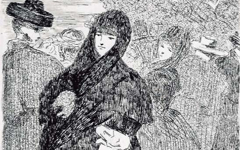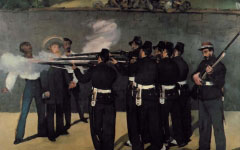Manet’s The Spanish Singer (1860)
This 1860 painting by the then little-known Manet caused such a stir among younger artists that they paid a group visit to his studio. Although those artists may have been excited about Manet’s novel technique, what concerns us is his meaning. Once again, it is the problems that others complain about that helps pave our way.
Although the figure of the singing guitarist seems Spanish even contemporaries noted that the costume was inauthentic and that he seemed posed in a studio. One criticized “the Marseilles-type jacket and the pants of this guitarrero from Montmartre.”1 Emile Zola remarked that while Manet’s public might suppose that his models were Spanish, they ought to know that Manet kept “Spanish costumes in his studio and liked their colors.”2

Manet, The Spanish Singer (1860) Oil on canvas. Metropolitan Museum of Art, New York.
Click image to enlarge.
The contemporary awareness of a studio setting and the mix of French and Spanish clothing is important because Manet must have intended what others can see. The underlying scene is therefore in a studio and, given that every painter paints himself, it should also represent an artist and a model. Manet was French, of course, inspired in part by Spanish masters so the Franco-Spanish fusion in his clothing represents the Franco-Spanish heritage in Manet's mind.
Click next thumbnail to continue

L: Manet, The Spanish Singer ; R: Watteau, Gilles; Center: a detail of Gilles.
Click image to enlarge.
This cultural fusion is further strengthened by the main reference in the singer’s Spanish-looking head. No-one has noted that it derives from the work of a French master, Watteau, and his well-known self-representation in Gilles.3 Note the similar hats over white headbands of the two “artists” and how Manet fused the singer’s face with the wide-mouthed expression of Watteau’s actor in white below. Manet would have known Watteau identified with Gilles and that Watteau had signified his own “sanctity” with a halo-like hat. Manet did likewise in black.
In addition artists often wore turbans in the studio or wrapped their heads in a handkerchief to keep paint off their hair. It may look fitting in the scene but the white kerchief under their hats has another purpose too, in both Watteau's painting and Manet's. Both figures are "painters".
Click next thumbnail to continue

Top L: Detail of The Spanish Singer
Top R: El Greco, detail inverted of St. Luke Painting the Virgin (before 1567)
Bottom L: Van Ostade, detail inverted of The Painter (c.1647)
Click image to enlarge.
Even the curious position of the guitarist's legs is based on how some painters rest theirs on the crossbar of an easel, as seen (below left) in Adriaen van Ostade's The Painter, a Dutch artist Manet admired. Even in a damaged icon by the young El Greco of St Luke painting the Virgin (top right), you can see the painter's raised leg on the bar. And both images by El Greco and van Ostade include a simple bench for their paint-pots like the one Manet's singer sits on. Manet's, painted green, the color of creativity, even has his signature on its right-hand edge.
Manet was also aware that many artists including Titian, Rembrandt and Rubens had used gold chains and other symbols of honor in their self-portraits to represent their mastery and achievement. In nineteenth-century France, though, gold chains as such had disappeared and the Legion d’Honneur was now the nation's highest honor, mainly worn as a small red rosette or short red ribbon. Here Manet disguises it as a short strip of red at the end of the guitar’s arm.
See conclusion below
Lastly, a look at what so many writers call an "error". Manet, they argue, painted a right-handed guitarist playing an instrument strung for a left-handed player and yet changed nothing when Baudelaire, shortly before its first exhibition, pointed out the problem. He later responded that he “had painted the head in one go” and that when “I looked at it in my little black mirror… it was all right. I never added another stroke.”4 Why did the sharp-witted Manet make mention of the mirror and why would he be so cavalier about the incorrect guitar-strings? Remember two points discussed elsewhere: great masters never make mistakes in their important works and their minds, like ours, are a mirror of reality. Is it coincidence, then, that when The Spanish Singer is looked at in a mirror, the guitar-strings resolve themselves? The player becomes left-handed while still playing a guitar strung for a left-handed player. No-one has noted that before nor that The Spanish Singer, as an image of Manet’s mind, mirrors reality.
More Works by Manet
Learn how Manet's crooked arms, repetitively appearing in his art, each come with meaning

Manet’s At the Prado
Notes:
1. Elie Lambert, “Manet et L’Espagne”, Gazette des Beaux-Arts, 6th ser. IX, June 1933, pp. 374-5, cited in Manet (Metropolitan Museum of Art) 1983, p. 63
2. Emile Zola, Salons, eds. Hemmings and Neiss (Geneva) 1959, p. 93, cited in Manet (op.cit.), p. 64
3. Dora Panofsky remarked that the figure of Gilles “has never failed to impress the beholder as an image of the artist’s own being.” Lind Nochlin more recently wrote that “among Gilles’s roles is that of artist’s double: the Clown Prince of Melancholy stands in for the Painter Prince of Evocation, simultaneously vulnerable and narcissistic at the same time.’ Panofsky, “Gilles or Pierrot?: Iconographic Notes on Watteau” Gazette des Beaux-Arts, XXXIX (1952) p. 330 ; Nochlin, “Watteau: Some Questions of Interpretation”, Art in America 73 (Jan. 1985), p. 71
4. Antonin Proust, “Edouard Manet: Souvenirs”, La Revue Blanche, Feb-May 1897, p.170 cited in Manet (op. cit.), p. 64
Original Publication Date on EPPH: 26 Sep 2010. | Updated: 0. © Simon Abrahams. Articles on this site are the copyright of Simon Abrahams. To use copyrighted material in print or other media for purposes beyond 'fair use', you must obtain permission from the copyright owner. Websites may link to this page without permission (please do) but may not reproduce the material on their own site without crediting Simon Abrahams and EPPH.



